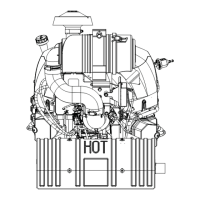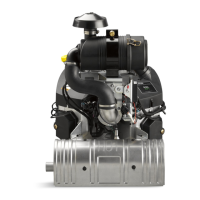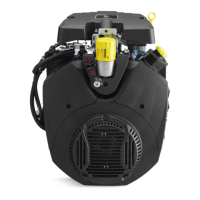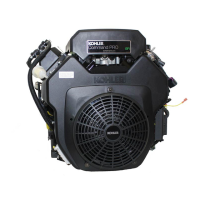Disassembly/Inspection and Service
78 19 690 01 Rev. --KohlerEngines.com
3. Once valve spring is compressed, remove following items:
● Valve spring keepers.
● Valve springs.
● Valve spring caps.
● Intake and exhaust valves (mark position).
● Valve stem seals.
4. Repeat above procedure for other cylinder head. Do not interchange parts from one cylinder head to another.
Inspection and Service
Valve Details
EXHAUST VALVE INTAKE VALVE
EXH
INT
H H
G
G
E
E
F
F
A
C
D
D
B
Dimension Intake Exhaust
A Seat Angle 89° 89°
B Seat Taper 30° 30°
C Guide Depth 7.65/8.05 mm (0.3012/0.3169 in.) 7.65/8.05 mm (0.3012/0.3169 in.)
D Guide I.D. 7.038/7.058 mm (0.2771/0.2779 in.) 7.038/7.058 mm (0.2771/0.2779 in.)
E Valve Head Diameter 38.600/38.805 mm (1.5197/1.5295 in.) 29.375/29.625 mm (1.1565/1.1663 in.)
F Valve Face Angle 45° 45°
G Valve Margin (Min.) 1.0 mm (0.0393 in.) 1.0 mm (0.0393 in.)
H Valve Stem Diameter 6.982/7.000 mm (0.2749/0.2756 in.) 6.970/6.988 mm (0.2744/0.2751 in.)
After cleaning, check fl atness of cylinder head and corresponding top surface of crankcase using a surface plate or
piece of glass and feeler gauge. Maximum allowable out of fl atness is 0.08 mm (0.0031 in.).
Carefully inspect valve mechanism parts. Inspect valve springs and related hardware for excessive wear or distortion.
Check valves and valve seat area or inserts for evidence of deep pitting, cracks, or distortion. Check clearance of
valve stems in guides.
Hard starting or loss of power accompanied by high fuel consumption may be symptoms of faulty valves. Although
these symptoms could also be attributed to worn rings, remove and check valves fi rst. After removal, clean valve
heads, faces, and stems with a power wire brush.
Then, carefully inspect each valve for defects such as a warped head, excessive corrosion, or a worn stem end.
Replace valves found to be in bad condition.

